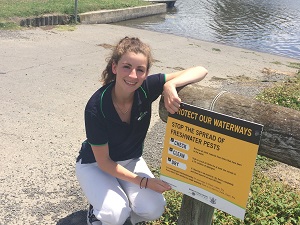I want to...
Current filter: Most popular
A to Z
Apply for a job
Biosecurity
Consents
Consultation
Contact Us
Environmental Data
Farmers Hub
Fix it or Report it
Information Request
Join an Event
Leasehold Land
Meetings
Rates
Water Metering
Have Your Say
Don’t spread freshwater pests this summer
Published: 18 January 2019

This summer Hawke’s Bay Regional Council and the Ministry for Primary Industries are again reminding everyone of the importance of cleaning any equipment that’s come into contact with freshwater.
The aim of the national Check Clean Dry campaign is to establish a habit to avoid the spread of unwanted freshwater pests including the invasive alga didymo. Signs are placed at key fishing and boating sites around the region.
“Unwanted freshwater pests such as didymo, lake snow, and hornwort pose a serious threat to our rivers, streams and lakes. Once in a waterway they can disperse rapidly and destroy the environmental, recreational and aesthetic values of our waterways,” says Hawke’s Bay’s Check Clean Dry Advocate Abby Wayte-Macredie. (seen in photo at the Clive River boat launch ramp).
Abby’s holiday job keeps her out at rivers and lakes talking to tourists and locals alike about the need to protect our freshwater from unwanted pests. Abby is a Napier student studying ecology at Victoria University of Wellington and is working for Hawke’s Bay Regional Council during her vacation.
“We want people moving between waterways to Check, Clean, Dry any equipment that has come into contact with river or lake water. Some freshwater pests, like didymo, are microscopic and can be spread by a single drop of water. Even if you can’t see the danger you could be spreading it.”
Abby says before leaving a waterway, people should check shoes, boats and trailers, fishing tackle or any other wet gear, and leave any weed or debris they find at the waterway.
“All items should then be cleaned for at least one minute with a five percent [5%] solution of biodegradable dishwashing solution. That’s about one tablespoon of detergent per 250ml.”
“Water absorbent materials such as lifejackets, wetsuits, shoes and boots require longer soaking times to allow thorough saturation.
“Drying will kill didymo, but even slightly moist items can harbour didymo and other microscopic pests for months. To ensure didymo cells are dead, the item must be completely dry to the touch, inside and out, then left dry for at least another 48 hours before use,” says Abby.
“Following these simple procedures will help slow freshwater pests like didymo from spreading throughout New Zealand waterways. It’s everyone’s responsibility to try to protect our waterways for future generations.”
Hawke’s Bay has its own invasive weed – Hydrilla – that is only found in Lakes Tutira, Waikapiro, Opouahi and Eland and should not be spread to other lakes. The regional council and MPI have been working to control it. Another problem weed, Lagarosiphon, is found in Lake Waikaremoana.
“Just remember to Check Clean Dry when moving from one waterway to another, anywhere in New Zealand.”
For more information about cleaning gear and unwanted pests go to www.mpi.govt.nz/check-clean-dry . To report suspected Didymo or other pests, phone the hotline immediately on 0800 99 66.
Background Notes
Didymo ( known casually as ‘rock snot’) is a freshwater diatom (a type of algae) that is currently found in over 150 South Island rivers, but not yet in the North Island. It is a microscopic pest that forms thick brown layers that smother rocks, submerged plants and other materials. Check here for more information.
Disclaimers and Copyright
While every endeavour has been taken by the Hawke's Bay Regional Council to ensure that the information on this website is
accurate and up to date, Hawke's Bay Regional Council shall not be liable for any loss suffered through the use, directly or indirectly, of information on this website. Information contained has been assembled in good faith.
Some of the information available in this site is from the New Zealand Public domain and supplied by relevant
government agencies. Hawke's Bay Regional Council cannot accept any liability for its accuracy or content.
Portions of the information and material on this site, including data, pages, documents, online
graphics and images are protected by copyright, unless specifically notified to the contrary. Externally sourced
information or material is copyright to the respective provider.
© Hawke's Bay Regional Council - www.hbrc.govt.nz / +64 6 835 9200 / info@hbrc.govt.nz


